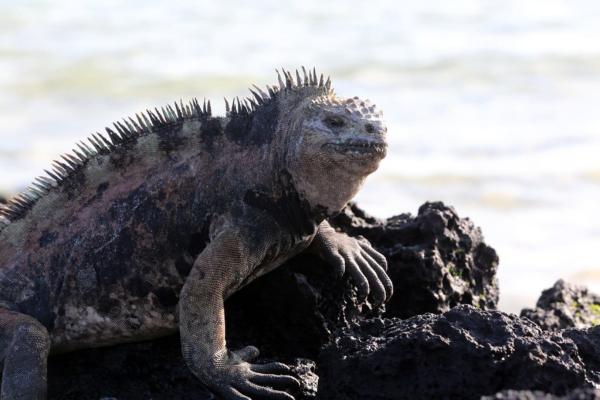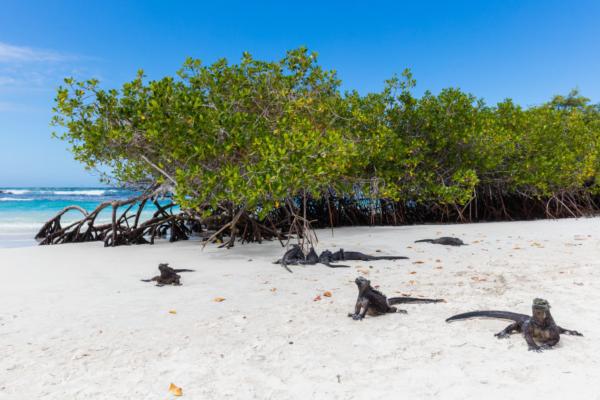The marine iguana (Amblyrhynchus cristatus) stands out as the world’s only ocean-going lizard, and is found exclusively on the Galápagos Islands. Thanks to millions of years of evolution on these volcanic islands, marine iguanas have developed unique features and habits that set them apart from all other lizards. This remarkable species is an icon of island adaptation and a symbol of Galápagos wildlife.

Only Sea-Faring Iguana: Unlike other iguanas, the marine iguana can forage underwater in the sea, using its pointed snout and sharp teeth to scrape algae from rocks.
Tough, Scaly Skin: Covered in keratinized scales, their skin is both water-resistant and protects them from rough ocean waves.
Long, Sharp Claws: These help the iguana grip slippery rocks and withstand strong tides while feeding.
Distinctive Dorsal Crest: A row of spines runs down their back, more pronounced in males, which are typically about 70% larger than females.
Strong Swimmers: With partially webbed limbs and a laterally flattened tail, marine iguanas swim by undulating their bodies, similar to eels.
Dark Coloring: Their black or dark gray coloration, sometimes tinged with red or green, helps them absorb heat quickly after a swim. As cold-blooded reptiles, they rely on sunbathing to regulate their temperature.
Slow Heart Rate Underwater: When diving, they can significantly reduce their heart rate to minimize heat loss.
Marine iguanas are endemic to Ecuador’s Galápagos Islands, inhabiting a total area of about 500 square kilometers. They are typically found on rocky shorelines, intertidal zones, and coastal regions of all major islands, including Baltra, Daphne, Darwin, Española, Marchena, Pinzón, Santa Fe, Seymour, and Wolf. Different island populations show variations in body size and color due to local conditions.

Specialized Algae Eater: Marine iguanas primarily feed on sea algae, preferring red and green varieties. When those are scarce, they may consume brown algae, though it is harder to digest.
Age-Related Foraging:
Juveniles feed mainly in the intertidal zone, as they cannot tolerate the cold ocean for long.
Adults can dive up to 30 meters deep in search of algae. Females often eat exposed algae at low tide.
Efficient Salt Regulation: Because of their salty diet, marine iguanas have specialized nasal glands that excrete concentrated salt, often seen as salt “sneezes.”
Opportunistic Eating: In times of shortage, they may also eat coastal succulents or other salty terrestrial plants.

Adapted for Hypoxia: Marine iguanas can remain underwater for 5–10 minutes, sometimes up to 30 minutes, due to a slow metabolism and high lactic acid tolerance.
Body Size Plasticity: Uniquely, their bone length can shrink during food shortages and grow again when food returns—a rare trait among vertebrates.
Vulnerable to Environmental Change:
Climate Change: El Niño events raise water temperatures and reduce nutrients, leading to brown algae blooms that are toxic or indigestible, often causing mass die-offs.
Invasive Species: Feral cats, dogs, rats, and pigs prey on eggs and young iguanas or transmit diseases.
Pollution: Oil spills, microplastics, agricultural chemicals, and waste pose significant risks.
Conservation Status: The IUCN lists the marine iguana as Vulnerable, with two subspecies considered Endangered.
Annual Breeding Cycle: Breeding timing depends on food availability and sea temperature.
Mating Behavior: When sexually mature, males become more colorful and aggressive, defending territories and courting females. Only dominant males control mating in their territory.
Egg Laying: After mating, females dig nests in sand or volcanic ash up to 2 kilometers inland, laying 1–6 eggs per clutch. Hatchlings feed on adult feces for their first two months to acquire gut bacteria for digesting algae.
Growth and Survival: The harsh environment and many predators mean survival is challenging for hatchlings.
The marine iguana is not only a marvel of evolution but also a critical component of the Galápagos ecosystem. Protecting this species requires active conservation: safeguarding its habitat, preventing invasive species, and minimizing human impact. The marine iguana’s story is a powerful reminder of the fragility and wonder of island biodiversity.
Want to learn more about ocean wildlife or Galápagos endemics? Explore our “Wildlife Encyclopedia” section for more!
Bibliography
Dawson, WR., Bartholomew, GA., & Bennett, AF. (1977). A reappraisal of the aquatic specializations of the Galapagos marine iguana (Amblyrhynchus cristatus). Available from: https://deepblue.lib.umich.edu/bitstream/handle/2027.42/137252/evo01083.pdf; sequence=1
Guerra-Correa, E., Rodríguez-Guerra, A. (2020). Amblyrhynchus cristatus. Available from: https://bioweb.bio/faunaweb/reptiliaweb/FichaEspecie/Amblyrhynchus%20cristatus
IUCN Red Lists of Threatened Species. Available from: https://www.iucnredlist.org/es
Torres, O. (2017). Amblyrhynchus cristatus, the world's only marine lizard. Available at: http://revistabionatura.com/2017.02.02.10.html
animal tags: marine iguana
We created this article in conjunction with AI technology, then made sure it was fact-checked and edited by a Animals Top editor.